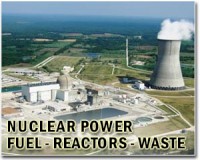 |
Paris (AFP) March 13, 2011 Evacuation, temporary shelter and iodine pills are the chief weapons for protecting civilians against nuclear fallout, experts say. A blast on Saturday that wrecked the concrete shell surrounding the No. 1 reactor at Japan's Fukushima nuclear plant released radioactive vapour but not at levels dangerous for human health, according to Japanese officials. Specialists say the authorities have a several-pronged strategy for shielding civilians if there is an explosive breach of the reactor, as in the April 26 1986 Chernobyl disaster. In that event, a cloud of radioactive dust spread over parts of Ukraine and Belarus, triggering a surge in cancer and birth defects. The death toll ranges from a UN 2005 estimate of 4,000 to tens or even hundreds of thousands, proposed by non-governmental groups. "There are three weapons against contamination -- evacuation, confinement and iodine," said Patrick Gourmelon, director of radioprotection at a French nuclear watchdog, the Institute for Radioprotection and Nuclear Safety (IRSN). About 200,000 people have already been evacuated from residential areas around Fukushima, located 250 kilometres (120 miles) north of Tokyo. Confinement is a highly effective tool pending evacuation to a safer area. It consists of taking shelter in an enclosed space, preferably a basement room, whose doors and windows are then sealed tight with plastic sheets and adhesive tape. "The point is to prevent radioactive dust from entering the lungs and the digestive tract," said Gourmelon. "You take a good shower to remove any contact between the fallout and the skin, but you shouldn't scrub, because this helps particles to penetrate," he said. Nail-biting, smoking and sucking or licking one's fingers are also out. In a nuclear alert, the authorities also hand out iodine pills to prevent cancers of the thyroid, which is a particular risk for babies, young children, teenagers and expectant or breast-feeding mothers. The goal is to saturate the thyroid with "healthy iodine," shielding it from radioactive iodine, said Gourmelon. Timing, though, is essential. Preferably, the iodine is taken an hour before a known fallout incident. Japanese guidelines say the pills should be distributed when the likely absorbed dose of radioactivity is 100 milligray, a unit named after a British physicist. "You can also take it in the following 24 hours after the incident," he said. "It does work but the protection is reduced to 25 percent." One of the many unknowns at Fukushima is the fate of plant personnel and emergency workers, who may have been exposed to a higher radiation risk.
Share This Article With Planet Earth
Related Links Nuclear Power News - Nuclear Science, Nuclear Technology Powering The World in the 21st Century at Energy-Daily.com
 Thousands near Japan nuclear plant told to evacuate
Thousands near Japan nuclear plant told to evacuateTokyo (AFP) March 12, 2011 The Japanese government on Friday declared an atomic emergency and told thousands of residents living near a nuclear plant in Fukushima to evacuate, warning a small amount of radiation could be released. Trade minister Banri Kaieda said authorities were nearing a decision to release radioactive steam from a troubled nuclear reactor in a bid to ease a pressure build-up after its cooling syste ... read more |
|
| The content herein, unless otherwise known to be public domain, are Copyright 1995-2010 - SpaceDaily. AFP and UPI Wire Stories are copyright Agence France-Presse and United Press International. ESA Portal Reports are copyright European Space Agency. All NASA sourced material is public domain. Additional copyrights may apply in whole or part to other bona fide parties. Advertising does not imply endorsement,agreement or approval of any opinions, statements or information provided by SpaceDaily on any Web page published or hosted by SpaceDaily. Privacy Statement |